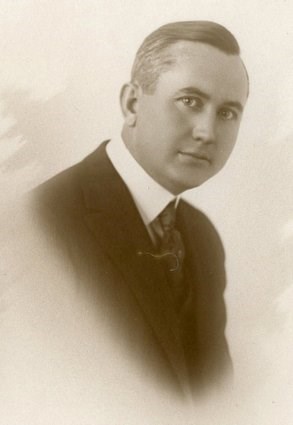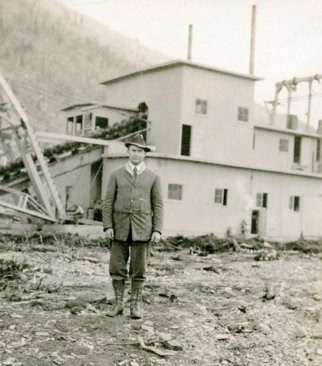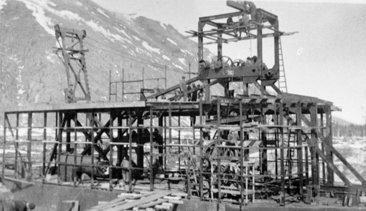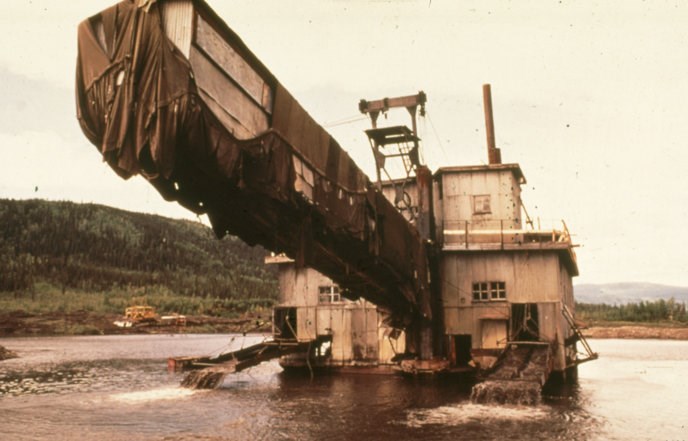
Courtesy of the Johnson Family —Popular Mechanics, 1938
During the Klondike-Alaska gold rush of 1898 the tools used in mining were rudimentary: picks, shovels, gold pans, box sluices, and hydraulic hoses. If they were lucky, miners had steam boilers that helped to thaw permanently frozen ground to get at the placer gold beneath. From the beginning men dreamed of machines that could increase their profits and relieve the back-breaking labor involved in "pick and shovel mining." Early in the new century that dream was realized when mammoth gold dredges were shipped north and began pulling millions from the frozen earth.
Engineering for gold
Born in Farmer's City, Illinois in 1882, Walter W. Johnson came from a modest background and earned money to pay his way through school by working on his uncle's farm. After earning a degree in mechanical engineering at the University of Illinois, he moved to California in 1905 where he married and began work in the dredge manufacturing industry. By 1910 Johnson had formed his own enterprise—the Union Construction Company—to design and build bucket-type dredges, prospecting drills, and other placer mining equipment. Mining companies purchased Johnson's dredges for use in Alaska, Canada, Siberia, Portugal, Bolivia, and across the United States. Thirty-two of the company's dredges (of a total production of 58) went to Alaska, twice as many as from any other dredge manufacturer. Johnson adapted his machines to Far North conditions, making him a gold dredge pioneer for Alaska.

Courtesy of the Johnson Family Starting in 1909, Johnson began traveling to Alaska to direct the construction of dredges near Nome and throughout the Seward Peninsula as well as in the Alaskan interior at Ruby, McGrath, Iditarod, Circle, and Fairbanks. And in the early years he brought his family—his wife Pearl and sons Keith and Paul—on these work trips that took them on lengthy Yukon River steamboat journeys and to some of Alaska's most remote mining districts. The dredges the Union Construction Company produced were built in San Francisco and then dismantled and shipped in pieces to Alaska. The parts were then transported to a specific gold claim and reassembled. Unlike the dredges Johnson designed for the tropics, the Alaskan machines faced cold and ice that curtailed the months they could operate and demanded that permanently frozen ground be thawed before it could be worked. Nevertheless, the Union Construction Company and other dredge-makers had discovered a winning strategy. As dredge expert Clark C. Spence explains, even early dredges were considered a safe investment:

UAF Archives, George Beck Photographs In 1935 the wealthy Canadian investor Alexander McRae was scouting locations for mining Alaskan gold on an industrial scale and after crisscrossing the territory, he selected a Yukon River tributary called Coal Creek where small-scale placer miners had been active for decades. At a cost of $156,000, McRae purchased a dredge from what was by that time called the Walter W. Johnson Company. The dredge began operation in 1936, and the following year McRae purchased a second nearly identical dredge for nearby Woodchopper Creek. Over the next three decades the twin dredges collected over $600,000,000 in gold and small amounts of silver, and today they remain, largely unchanged, inside Yukon-Charley Rivers National Preserve. After the Klondike-Alaska gold rush, much of the easy pickings were gone and primitive mining techniques were not enough to sustain the gold industry in Alaska. Walter Johnson deserves to be recognized for revolutionizing gold mining by creating machines that could do the work of a thousand men and find profit where before the ground was poor and impenetrable. Today the colossal hulks of gold dredges remain in many of Alaska's mining districts, and although they are now silent, they whisper of past glories.

NPS |
Last updated: April 14, 2015
